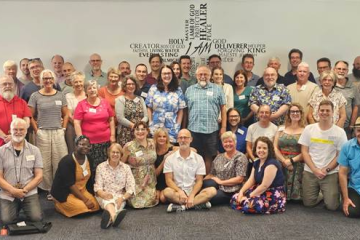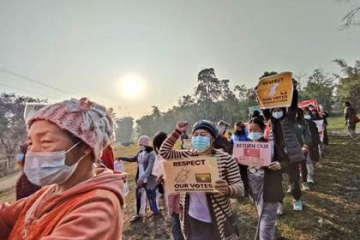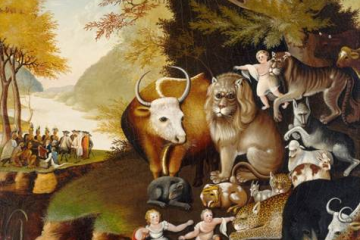The grace of God is glue – Luke 8:26-39 and Galatians 3:23-29
Many years ago, I worked at the National Council of Churches in Sydney, and I had a colleague whose husband was an Anglican priest. It was around the time the Sydney Diocese was debating women’s ordination and, courting some controversy, he invited a female priest (from another diocese) to preach. The passage for the day was the story of the Gerasene demoniac we have just read, and because he’d heard the sermon at the first service, he decided to duck back to the manse for something during the second service… No one noticed, except his wife – my colleague – who was worried about how this might look, but as he left, she realised she could hear traffic noise, his footsteps on the concrete path and then the unmistakable sound of their side gate… She rushed out to tell him to turn off his mic – just as the preacher said, “And the Gerasene demoniac fell down before Jesus and shouted at the top of his voice…” And her husband’s voice chimed in, “Here, kitty, kitty, kitty. Here, puss, puss, puss.”
It’s my all-time favourite microphone story. It’s very funny.
But what the man who Jesus meets in the country of the Gerasenes which is opposite Galilee (i.e. where the people were not Jewish) has been experiencing is not funny. “For a long time” we are told (verse 27), “he had worn no clothes, and he did not live in a house but in the tombs….For many times (verse 29) [the demon] had seized him…” Here is a person whose suffering and mental disorder and social isolation is acute.
These days we read into biblical accounts of demon possession and exorcism our modern understanding of mental illness. This might be clarifying, but we must not label mental illness as demon possession by another name. We know that mental health is physical health; that diseases of the brain result from a complex web of environmental, hereditary, experiential, and other causes.
In the first century world, however, belief in demons was abundant. Each group of demons was understood to be under the direction of a greater power. And what this passage tells us, the significance of Jesus having travelled to the country of the Gerasenes, is that Jesus has power even over Gentile demons. Professor of New Testament, Sarah Henrich writes, “When Jesus consigns these demons to the pigs, he demonstrates the universality of his power…. The Messiah of the God of the Jews has power that is not limited to Jews alone….”
Jesus has the power to heal this man – this man who is a Gentile and whose situation is so terrible. He is, to refer to our last hymn, the Word that is comfort, the Word that remembers, that restores this man’s life, the Word that names the discontent, the Word that listens. And, ultimately, the Word that makes him free and well. In verse 35, we read, “people came out to see what had happened…[and] they found the man… sitting at the feet of Jesus, clothed and in his right mind…. Those who had seen it told them how the one who had been possessed by demons had been… “– and the Greek word here is sozo – which can be translated ‘healed’ or ‘saved’, or ‘made whole’.
I am reminded of one of my favourite quotes by American playwright Eugene O’Neill, “Man is born broken. He lives by mending. The grace of God is glue.”
This man is not bound by chains and shackles, but glued whole by the grace of God. And his community find him sitting – again someone sitting in the place of a disciple – at the feet of Jesus. Because this is where everyone who experiences the grace of God that heals us and holds us together sits. This is who we become – disciples of Jesus.
We know now, as I said earlier that mental health is physical health, and that treating diseases of the brain can be complex and can take time and can be ongoing – just as diseases of the body are. I do not want anyone to go away from here thinking this picture of the man sitting at Jesus feet, the man having become a disciple, means that healing – whether it is mental and physical – should be instantaneous. I don’t believe this is what the passage is saying. After all, sitting at Jesus feet, being a disciple, is an ongoing process.
One in five of us experience mental illness every year, and 45 per cent – virtually half of us – will be affected by mental illness at some time in our lives. Churches are often not very good about talking about this. Mental health is the “non-casserole” disease as one writer put it!
In 2019 I was diagnosed with depression. It was – as I said earlier – the result of a complex web of environmental, hereditary and experiential causes, and healing and wholeness – salvation – also involved a complex web of support and care. There was my GP and the psychologist I worked with for almost a year. There was medication to help me sleep. There was my spiritual director who helped me name the layers of shame that people, me included, were imposing on me. There was my family who stood beside me. And good friends. And there was a long slow process, over three or so years, of good days and bad days, of constantly having to re-focus on what would foster good health; sleep, exercise, education (or creative stimulation), diet and social connection.
For me, it was all those things, which became part of an ongoing process of sitting at Jesus’ feet and being a disciple.
But that is not where the story in Luke ends. Yes. This is the story of how the grace of God glued one man’s life back together. But this man’s community remains broken and bound. Verse 37 tells us that they were seized – they were bound or held – by a great fear.
Why are they so bound by fear? Some say it’s a reaction to the economic loss of the pigs. Others that they were simply afraid of Jesus and his power. But I am drawn to those who – like the social philosopher Rene Girard – point out that this man was the scapegoat for this whole community; the one identified as the cause of the group’s problems, the one punished for the group’s sins.
There were different ways scapegoats were dealt with in the first century. They could be driven away into the wilds. They could be stoned. Or they could be forced over a cliff. You might remember, in Luke chapter 4, after Jesus’ sermon in the synagogue in Nazareth, “They got up, drove him out of the town, and led him to the brow of the hill on which their town was built, so that they might hurl him off the cliff.”
But in Luke 8, rather than the scapegoat being hurled off the cliff, the demons hurl themselves off the cliff, and by the grace of God, the man goes free.
According to Rene Girard the miracle of the Gerasenes is not just that the man is healed, but that in the universal power of Christ the community is offered a way to healing and wholeness, a way out of scapegoating and ‘the universal schema of violence fundamental to all societies of the world.’
Jesus comes to heal and save and make us whole again. Jesus – in his life and in his death – offers us the grace of God that glues us back together as individuals and as groups of people and makes us one in Christ.
Once again, we are reminded that this story begins with Jesus going from Galilee to the opposite side, to the country of the Gerasenes. A Jew going to their opposite, a Gentile.
And so, Paul speaks of this work of God reconciling opposites in our passage from Galatians: “There is no longer Jew or Greek, there is no longer slave or free, there is no longer male and female, for all are one in Christ Jesus.” The markers of social identity and status that used to hold us apart are now secondary to our identity as those who are held together – who are made one – through the reconciling work of Christ.
At the conclusion of our passage the man begs to go with Jesus, but Jesus sends him on his way, saying, “Return to your home and declare how much God has done for you.”
“We are all broken. We live by mending. The grace of God is glue.”
As people whose brokenness has been healed, who have been glued together and glued to all who share the grace of God, we are called to live by mending. We are called to work alongside God in showing a way out of brokenness and fear and scapegoating – by declaring through our lives and our words – and through the radical diversity and shared love of our community – what God has done for us


